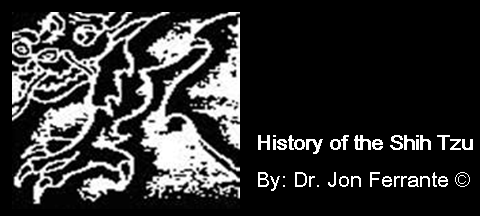History
 |
The Shih Tzu breed has only “recently” been introduced into the United States but its history is ancient, having its origin in China and possibly Tibet. Documentary evidence of the breed dates back to 824 A.D. and drawings found in the Forbidden City during the reign of the last Emperor Pu Yi by eunuchs who cared for the Shih Tzu and other Chinese dogs in the Forbidden City, date from the Tang Dynasty during the rule of the “Talented One,” who was known as the Empress Wu. Legend has it that some of the smaller breeds were bred to the Maltese type dogs that made their way to China via the Silk Road from the West. These Melitae or Maltese dogs were favored by the Roman nobility and royalty and it was the Phoenicians who actually were responsible for the dissemination of the small breed and many other breeds to various parts of the known world. The Empress Wu reigned during what is known as the “Golden Age” of the Chinese Empire and fostered the breeding of exotic and fierce looking little dogs that resembled the lion. Only members of the Chinese imperial family were permitted to own Shih Tzu. Special gardens and pavilions were maintained in the palace for their play and living quarters. The eunuchs, whose essential duties were to serve the royal family, also selected amongst themselves the eunuchs whose primary duties were to care for and to breed the finest specimens of Shih Tzu and other breeds. The finest specimens were presented to the Emperors.
The Dowager Empress, Yeonala, also known as “Orchid” to family members, was the last patroness of the breed in the Imperial Palace in the Forbidden City in the late 19th century and early 20th century. It was she who was steadfast in her devotion to the Shih Tzu above all other small breeds in the Imperial Palaces. Although the Pekingese and the Pug Dogs were also highly favored, the Shih Tzu were the only dogs that were permitted to wander into certain sacred territories in the Forbidden City, and were the only breed permitted to wander into the Temple of Heavenly Purity with the Dowager Empress. The reason for their privileged status was that the Dowager Empress believed that the Shih Tzu had the sweetest of temperaments of all of the Chinese breeds of dogs, and thus accorded the breed the status of “the sweet little ones, with the essence of purity.” A recent group of American military contractors who were visiting the Forbidden City in Beijing, and the Palace Museum in Taiwan, headed by retired U.S. Navy Commander, Kenneth W. Strickland, were allowed access to records hitherto not seen by Westerners. The records, some of them written on scrolls, were reportedly saved from the disastrous fire that swept certain libraries and pavilions in the Forbidden City after the death of the Dowager Empress. It is said that the eunuchs were blamed for initiating the great fire in order to cover their theft of voluminous treasures within the palaces. But the accusations were never proved, and the fires may well have been accidental in origin.
There was vigorous competition among the eunuchs to breed excellent specimens to gain rewards and favors from the Dowager Empress. The fact that the breeding was done exclusively in the palaces of the emperors kept the type of breed under close control over the centuries. “Foreign Devils,” were named as for many reasons but the principle reason was because of the opium trade from the West into China. Opium was in part responsible for the social and economic decline of the Chinese Empire. Westerners were not permitted to obtain Shih Tzu, and they could not be exported. Only in relatively recent years, mainly in the early 20th Century, was it possible for people in diplomatic posts to secretly, and without authority, bring specimens of the breed out of China. The Dowager Empress frowned on the attentions that any of the Western visitors visiting her in the Forbidden City gave her favorite dogs, or if they handled or lavished affections on the dogs. The attentions, she felt should be hers, and she was certainly very territorial in her attitudes concerning her dogs.
Shih Tzu were secretly smuggled out of the Palace by the eunuchs. Poor specimens not meeting the approval of the fastidious eye of the Dowager Empress, or the chief eunuchs who had influence on the dog breeding programs even before the Dowager Empress had seen or evaluated new litters of puppies, were given away or sold to Chinese of noble rank, and to wealthy Westerners with diplomatic privileges without the knowledge of the Dowager Empress. The eunuchs tried to avoid the scrutiny and critical eyes and critical comments of the Dowager Empress, by all means, if possible and they therefore eliminated the poor specimens, or they smuggled them out of the Forbidden City, and into the hands of outsiders. The smuggled individuals were often able to escape the scrutiny of fewer and fewer numbers of astute Chinese authorities who were paid to watch the flow of certain animals. Many of the authorities were incoherent due to their use of opium and other opiate derived drugs and were not astute with their responsibilities and record keeping, thus allowing the little dogs to squeeze through otherwise guarded passage ways, out of the palaces and pavilions of the Forbidden City, and ultimately out of China.
The first Shih Tzu arrived into England, parts of Northern Europe, and into Scandinavia as recently as 1930. They were recognized by kennel clubs in Hong Kong and eventually by the Federation Cynologique Internationale (FCI.) They were recognized by the British Kennel Club in 1934. In 1955 nearly 700 dogs were registered in England and the United Kingdom, and many were sold to owners in the U.S. and other countries. In 1969 the breed was recognized by the American Kennel Club and placed in the Toy Group.
